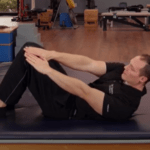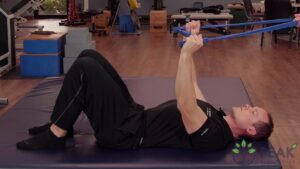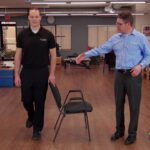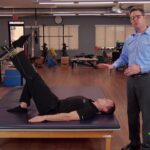Supine Crunch Exercise for Healthy Back & Abs
What is a Supine Crunch?
A supine crunch is an effective core strengthening exercise that targets the rectus abdominis muscle group. This exercise is performed while lying on your back with your knees bent and your feet flat on the floor. The supine crunch involves lifting your upper back off the floor towards your knees while keeping your lower back in contact with the floor.
To perform a supine crunch, start by lying on your back with your knees bent and your feet flat on the floor. Place your hands behind your head and contract your abdominal muscles to lift your head and shoulders off the ground. Keep your elbows wide and pointing outwards to prevent your neck from straining.
Exhale as you lift your head and shoulders, and inhale as you lower them back to the starting position. Focus on engaging your abs and avoiding any jerky or sudden movements. Repeat for the desired number of repetitions.
Supine crunches are a great way to improve core strength and stability, which can help prevent back pain and improve posture. They are also a low-impact exercise that can be modified to suit your fitness level. Beginners can start with fewer repetitions and work up to more as they gain strength. Advanced exercisers can add weight or resistance to increase the challenge.
Note: you can also do an oblique crunch by reaching the outside of the opposite side of one knee. Typically hold it for 2-3 seconds. Do the entire sequence on each side for 5 repetitions.
Early Intervention Benefits of this Exercise
The supine crunch exercise primarily targets the abdominal muscles. By performing it regularly, several early intervention health benefits can be offered, such as:
- Improved core strength. The supine crunch exercise engages the rectus abdominis, obliques, and other core muscles, leading to a stronger and more stable core.
- Increased flexibility. The exercise involves moving the upper and lower body simultaneously, which can improve flexibility and range of motion in the hips and lower back.
- Reduced risk of injury. A strong core can help stabilize the spine, reducing the risk of lower back pain and injury.
- Better posture. Strong core muscles help support the spine and improve posture, reducing the risk of neck and shoulder pain caused by poor posture.
- Improved athletic performance. A strong core is essential for most athletic activities. Furthermore, by incorporating supine crunches into a regular exercise routine, one can improve overall athletic performance.
- Weight loss and improved body composition. As a resistance exercise, the supine crunch can help build lean muscle mass in the abdominal area, which leads to improved body composition and weight loss over time.
While the supine crunch can be a beneficial exercise, it should be performed correctly to avoid injury. It’s recommended to consult with a qualified fitness professional to ensure proper form and technique.
These early intervention exercises are to improve health and fitness.
If you have an injury or illness, consult with a health care professional before attempting.
More Tools & Resources from Peak Ergonomics
Contact Us About Reducing Workplace Injuries
Healthy Employees are the Bottom Line! – Learn More!




